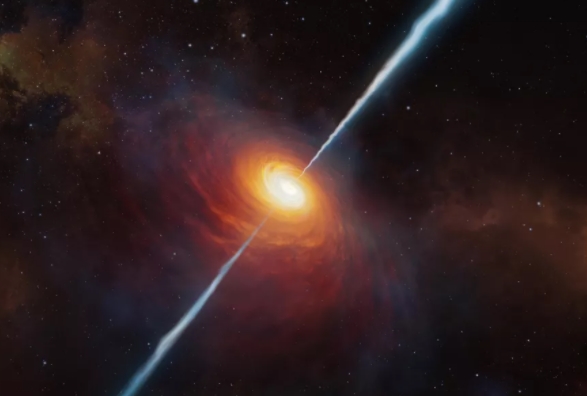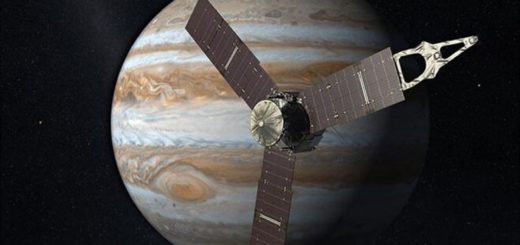Bursting from an ancient black hole, astronomers discover most distant cosmic jet

P172+18 is the most distant radio-loud quasar ever found. It could teach us how galaxies form and evolve.
If you’re fascinated by the idea of looking back in time, just look up at the sky. If you stare at the moon, you’re seeing the orb as it was around 1.3 seconds ago. Pointing your telescope at Mars? You’re seeing it as it was around 20 minutes ago. That’s how long it takes for light to travel those vast distances across the solar system. With a big-enough telescope, you can see light from the earliest moments of the universe, some 13 billion years ago.
Peering into a distant corner of space in 2015 with telescopes in Hawaii, astronomers found a bright and distant object from when the universe was only around 780 million years old. And it was record-breaking. Follow-up observations confirmed they’d discovered a huge jet of material emanating from a supermassive black hole that lived during the earliest epoch of the cosmos.
In a study, published in The Astrophysical Journal on Monday, the researchers detail the jet and its home quasar, which lies about 13 billion light-years from Earth. Officially, the quasar is called PSO J172.3556+18.7734, but scientists have, fortunately, nicknamed it P172+18.
Let’s step back a little, though. A quasar is a distant, bright supermassive black hole at the center of ancient galaxies. While black holes themselves are invisible, those at the heart of quasars are so massive that they draw in the gas and debris circling them at great speed in what’s known as an accretion disk, heating the material up and releasing extreme amounts of energy. This makes them incredibly luminous. Quasars have been discovered that are thousands of times brighter than the Milky Way.
While illustrations of the quasars often dazzle (like the one above), scientists only see them as a pinprick of light a few pixels wide on readouts from telescope data.
QUASARS: EXTREMELY BRIGHT AND INCREDIBLY DISTANT
Astronomers just found the oldest supermassive black hole yet
A rare, new type of galaxy on the brink of death
This particular quasar is a record-breaker because of the cosmic jet, which blasts out perpendicular to the accretion disk. It’s only about 1,000 years old. Cosmic jets are super-high-speed material being blasted out of the galaxy’s center, and they throw off a ton of energy as radio waves when they interact with the galaxy’s gas. Astronomers class these types of quasars as “radio-loud” and believe the jets may help black holes grow and could play a role in how a galaxy forms and evolves.
nrao21df03-vlba-close
This elongated image of P172+18 shows the inner part of the jet
Momjian et al., NRAO/AUI/NSF
“Jets have a role in regulating star formation and the growth of their host galaxies, so this discovery is valuable to understanding these processes in the early universe,” said Chris Carilli, an astronomer at the National Radio Astronomy Observatory and a co-author on the study.
But only around 10% of quasars are radio-loud, and this one, at some 13 billion light-years away, is the most distant ever found.
P172+18 isn’t the most distant quasar ever found, however. That record belongs to J0313-1806, which houses the oldest supermassive black hole scientists have yet discovered and resides about 13.03 billion light-years from Earth. That was discovered by the Atacama Large Millimeter/submillimeter Array, which is particularly adept at spotting very ancient, very distant cosmic phenomena. When NASA’s next-generation James Webb Space Telescope launches later in the year, it too should help probe the early universe even more.
It’s almost a certainty that records will continue to tumble.
“This discovery makes me optimistic, and I believe — and hope — that the distance record will be broken soon,” said Eduardo Bañados, an astronomer at Germany’s Max Planck Institute for Astronomy.



 Creators of mankind
Creators of mankind Description of “Tall white aliens”
Description of “Tall white aliens” Where they came from?
Where they came from? About hostile civilizations
About hostile civilizations The war for the Earth
The war for the Earth “Tall white aliens” about eternal life
“Tall white aliens” about eternal life Video: “Nordic aliens”
Video: “Nordic aliens” Aliens
Aliens Alien encounters
Alien encounters The aliens base
The aliens base UFO
UFO Technology UFO
Technology UFO Underground civilization
Underground civilization Ancient alien artifacts
Ancient alien artifacts Military and UFO
Military and UFO Mysteries and hypotheses
Mysteries and hypotheses Scientific facts
Scientific facts


















